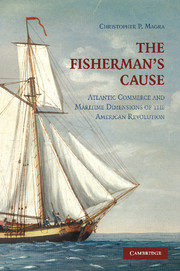Book contents
- Frontmatter
- Contents
- Acknowledgments
- Abbreviations
- Introduction
- Part One THE RISE OF THE COLONIAL COD FISHERIES
- Part Two ATLANTIC ORIGINS OF THE AMERICAN REVOLUTIONARY WAR
- Part Three THE MILITARY MOBILIZATION OF THE FISHING INDUSTRY
- 8 From Trade Routes to Supply Lines
- 9 The First American Navy
- 10 Starving the Enemy and Feeding the Troops
- 11 From Fishermen to Fighting Men
- Conclusion
- Index
- References
9 - The First American Navy
Published online by Cambridge University Press: 03 July 2009
- Frontmatter
- Contents
- Acknowledgments
- Abbreviations
- Introduction
- Part One THE RISE OF THE COLONIAL COD FISHERIES
- Part Two ATLANTIC ORIGINS OF THE AMERICAN REVOLUTIONARY WAR
- Part Three THE MILITARY MOBILIZATION OF THE FISHING INDUSTRY
- 8 From Trade Routes to Supply Lines
- 9 The First American Navy
- 10 Starving the Enemy and Feeding the Troops
- 11 From Fishermen to Fighting Men
- Conclusion
- Index
- References
Summary
The stagnation of the Fishery furnished us with means for cruising against the enemy's property.
An interventionist British state and the coming of the American Revolutionary War spoiled the lucrative commercial fishing industry in New England. In April 1776, fish merchants in Cape Ann, Massachusetts, estimated that their fleet of “80 fishing Schooners” had declined in value from “£300” to “£150 Each,” because they had been idled as a direct result of the war. The merchants claimed a loss of £12,000 for this redundancy, in addition to £6,000 for “Materials for Curing fish; Lost Wholly” and £8,000 “Loss on the Income of 80 Sail fishing Vessels a[t] £100 Each.” At the same time, Salem merchants reported that their fleet of fifty “Fishing Vessels” was worth half as much as a result of the war, and they claimed a loss of £7,500 for this depreciation. Salemites further claimed losses of £2,500 for “Materials for curing & Drying fish” that were “Totally Destroyed” and £5,000 for “the Loss of the Fishing 1 Year.” For their part, fish merchants in Chatham, Massachusetts, took stock after the war and calculated that they lost twenty-three of their twenty-seven fishing vessels as a direct result of the conflict. The large gaps in fish merchants' ledger books between 1775 and 1783 further attest to the war-induced decline in the production of dried, salted cod.
- Type
- Chapter
- Information
- The Fisherman's CauseAtlantic Commerce and Maritime Dimensions of the American Revolution, pp. 177 - 198Publisher: Cambridge University PressPrint publication year: 2009



